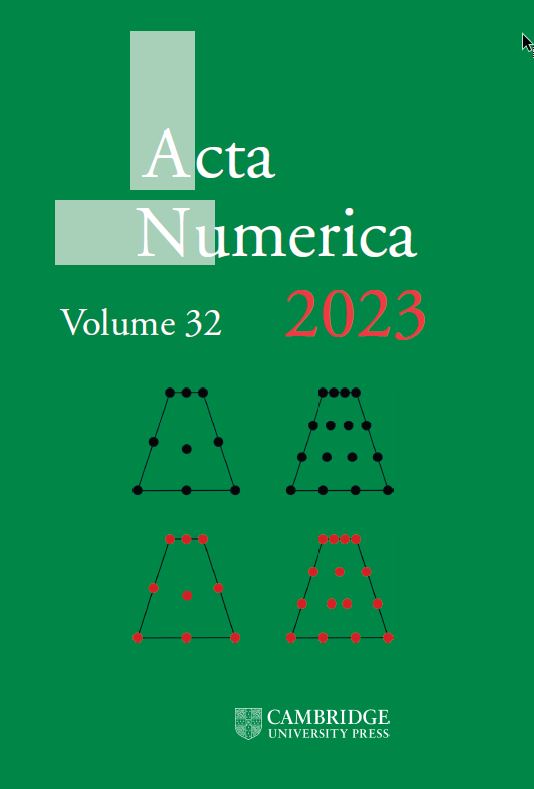混合整数非线性优化*†
IF 11.3
1区 数学
Q1 MATHEMATICS
引用次数: 622
摘要
在科学、工程和公共部门的应用中,许多最优决策问题都涉及到离散决策和非线性系统动力学,它们会影响最终设计或规划的质量。这些决策问题导致混合整数非线性规划(MINLP)问题,该问题结合了在离散变量集上优化的组合困难和处理非线性函数的挑战。我们回顾了MINLP的模型和应用,并调查了解决这类具有挑战性问题的方法的最新进展。大多数MINLP的解决方法都采用某种形式的树搜索。我们将方法分为两大类:单树方法和多树方法。我们首先在底层问题函数为凸的情况下讨论这两类方法。经典的单树方法包括非线性分支定界法和分支切法,经典的多树方法包括外逼近法和Benders分解法。对于凸MINLP来说,最有效的一类方法是结合了这两类经典技术优势的混合方法。非凸minlp带来了额外的挑战,因为它们在目标函数或约束中包含非凸函数;因此,即使将整型变量松弛为连续,可行域也一般是非凸的,从而产生许多局部极小值。我们讨论了一系列解决这类具有挑战性的问题的方法,包括分段线性近似、获得非凸函数凸松弛的一般策略、空间分支定界方法,以及利用特定类型的非凸结构来获得改进凸松弛的小样本技术。我们以简要讨论MINLP的三个重要方面来结束我们的调查。首先,我们回顾了启发式技术,它可以在搜索树增长过大或我们需要实时解决方案的情况下获得良好的可行解决方案。其次,我们描述了一个新兴的混合整数最优控制领域,它将常微分方程系统添加到MINLP中。第三,我们调查了当前MINLP软件的发展状况。本文章由计算机程序翻译,如有差异,请以英文原文为准。
Mixed-integer nonlinear optimization*†
Many optimal decision problems in scientific, engineering, and public sector applications involve both discrete decisions and nonlinear system dynamics that affect the quality of the final design or plan. These decision problems lead to mixed-integer nonlinear programming (MINLP) problems that combine the combinatorial difficulty of optimizing over discrete variable sets with the challenges of handling nonlinear functions. We review models and applications of MINLP, and survey the state of the art in methods for solving this challenging class of problems. Most solution methods for MINLP apply some form of tree search. We distinguish two broad classes of methods: single-tree and multitree methods. We discuss these two classes of methods first in the case where the underlying problem functions are convex. Classical single-tree methods include nonlinear branch-and-bound and branch-and-cut methods, while classical multitree methods include outer approximation and Benders decomposition. The most efficient class of methods for convex MINLP are hybrid methods that combine the strengths of both classes of classical techniques. Non-convex MINLPs pose additional challenges, because they contain non-convex functions in the objective function or the constraints; hence even when the integer variables are relaxed to be continuous, the feasible region is generally non-convex, resulting in many local minima. We discuss a range of approaches for tackling this challenging class of problems, including piecewise linear approximations, generic strategies for obtaining convex relaxations for non-convex functions, spatial branch-and-bound methods, and a small sample of techniques that exploit particular types of non-convex structures to obtain improved convex relaxations. We finish our survey with a brief discussion of three important aspects of MINLP. First, we review heuristic techniques that can obtain good feasible solution in situations where the search-tree has grown too large or we require real-time solutions. Second, we describe an emerging area of mixed-integer optimal control that adds systems of ordinary differential equations to MINLP. Third, we survey the state of the art in software for MINLP.
求助全文
通过发布文献求助,成功后即可免费获取论文全文。
去求助
来源期刊

Acta Numerica
MATHEMATICS-
CiteScore
26.00
自引率
0.70%
发文量
7
期刊介绍:
Acta Numerica stands as the preeminent mathematics journal, ranking highest in both Impact Factor and MCQ metrics. This annual journal features a collection of review articles that showcase survey papers authored by prominent researchers in numerical analysis, scientific computing, and computational mathematics. These papers deliver comprehensive overviews of recent advances, offering state-of-the-art techniques and analyses.
Encompassing the entirety of numerical analysis, the articles are crafted in an accessible style, catering to researchers at all levels and serving as valuable teaching aids for advanced instruction. The broad subject areas covered include computational methods in linear algebra, optimization, ordinary and partial differential equations, approximation theory, stochastic analysis, nonlinear dynamical systems, as well as the application of computational techniques in science and engineering. Acta Numerica also delves into the mathematical theory underpinning numerical methods, making it a versatile and authoritative resource in the field of mathematics.
 求助内容:
求助内容: 应助结果提醒方式:
应助结果提醒方式:


